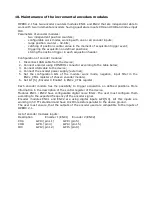
3. Starting the work with the device
OPBOX-2.1 is powered from USB interface and is conform with USB2.0 standard. According
to its requirements there are some limits, concerning power supply (max. start current,
max. continuous power). To fulfill this standard requirements OPBOX 2.1 has three
independent power supply branches (analogue part, 12V part and ADC/DAC converters
part). Each branch has independent signals, switching it and showing error conditions.
After connecting the device to the USB port, all three branches are switched off and only
digital part, responsible for communication is working. Before starting to work with the
device (triggering acquisition) the user application must switch on the power supply of all
remaining branches.
Switching on sequence:
1. Setting bit [0] „Power Enable” in POWER_CTRL register;
2. Checking bit [4] „Power OK” in reg. POWER_CTRL until the value '1' will occur.
If the flag „Power OK” is set, the device is ready to work.
1. In each moment the user can check status flags of all power supply branches: „ANALOG
PWR Status”, „DC12V Status” and „VREG Status” in POWER_CTRL register.
Switching off analogue branch of the device causes loss of DAC converter settings, thus
after each switching on sequence it is necessary to actualize some device settings:
1.
PULSE_AMPLITUDE (commend: (0xD6));
2.
Amplifier setting – register CONST_GAIN (Address: 0x28).
If the device cannot switch on the power in a correct way (the flag „power ON“ is not set
during few seconds) it is necessary to control the following:
1.
USB cable – if it is not damaged, of poor quality or too long;
2.
The cable should be replaced, the condition of the device controlled again;
3.
DB15 connector should be disconnected, if used and the device condition should be
controlled again;
4.
The device should be connected to another computer and checked again.
During data acquisition the device automatically block the measurement command, if any of
status flags signals a failure. In the case if the voltage of USB power supply falls
significantly during 100ms, the device automatically restarts the power supply sequence,
switching off all power supply branches and than switching them on again. During this time
all data acquisitions are blocked.
In the header of each acquisition status byte TriggerOverrunSource is written (byte 8) – it
contains the information about the source of lost triggers since last completed till actual
acquisition. If during this time one or more triggers couldn't be executed due to the failure
or overload of power supply, the flag „TrgOvrScr“ will be set to „1“.
4. Introduction to data acquisition settings.
The data acquisition system in OPBOX 2.1 (firmware rev. 2.1.60) was designed with the
goal to reach a real time acquisition speed (PRF) of up to 10000 measurements per second.
The device stores the data in internal memory and allows the software to read the data in
packets. This allows to reach high medium speed of measurement data for different sizes of
measurement windows and limits the necessity to communicate with the device on the level of
control functions (inquires, confirmations, readings of results from measurement gates,
encoder positions, etc.)
4.1. Basic features of acquisition in FIFO mode:
–
Allows to make the acquisition in real time, until the buffer is full, without the need to
read the data. This allows to reach high speed of measurements repetition (PRF).
–
Large hardware FIFO buffer (256kB) ensures stable PRF and allows to reach the
independence from the fluctuation of data speed on the USB interface;
–
System controller ensures the priority of acquisition trigger, interrupting the reading
during the acquisition time and starting it again, after the measurement is made.
–
Each measurement cycles creates in memory a data frame, where first 54 bytes are a



































